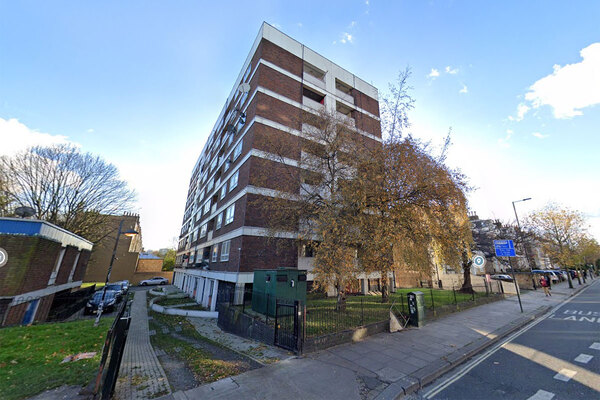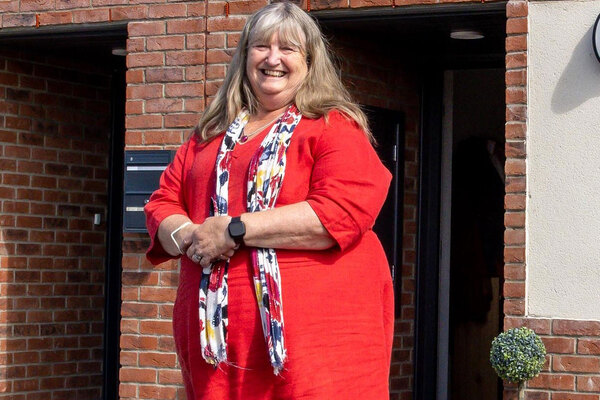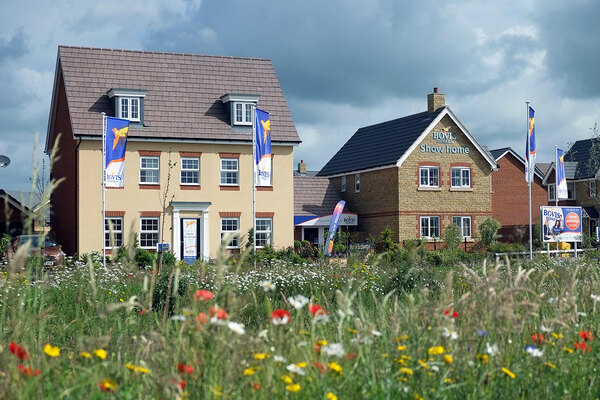You are viewing 1 of your 1 free articles
Homes to order
Factory-built homes are meant to be the next big thing. But what will the legacy be for those trying to maintain them? Jess McCabe reports

Source: Spooky Pooka
Offsite construction is becoming a buzzword. Earlier this year, Eric Pickles waxed lyrical in the Evening Standard about this modern method of building homes in factories.
After visiting Circle Housing’s 51-home development of affordable housing in Rainham, Essex, the communities secretary praised both the high energy efficiency standards of the Passivhaus homes – and the fact they have been built at a rate of one a day. Or, as he put it, the speed of construction is the ‘cherry on the strudel’.
Increasing supply
Alex Goodfellow: ‘Cost effectiveness is a major part of the attraction’
Last month, at a Housing Forum event, the deputy London mayor Richard Blakeway said that offsite construction may help London double its housing supply, to meet the growing demand that is predicted up to 2050. ‘We’re actively talking to registered providers who have a programme with us about using modern methods of construction,’ he added.
At the same event, Dale Meredith, group director of development at Southern Housing Group, said: ‘It’s already about assembly on site. It’s not about building anymore, it’s just about a kit of parts that are assembled.’
Faced with a growing housing crisis, and construction rates that are nowhere near meeting demand, maybe it’s not a surprise that government ministers and housing providers alike are eyeing the potential of factory-built homes with excitement. They go up fast. They are technological and new. And, the sales pitch goes, they avoid some of the defects that are common in human-based construction methods.
‘Cost effectiveness is a major part of the attraction,’ says Alex Goodfellow, group managing director of Stewart Milne Timber Systems, a firm which makes the timber frames for buildings in the factory. ‘The savings associated with the use of timber systems includes a reduction in preliminary costs of up to 30%. There are savings in labour due to less resource required on site, and with these lightweight structures there are also savings in foundation costs. Add to that the reduction in site waste and improved health and safety, and you can see why it’s becoming popular.’
The hope is also that, as the technique is new, hi-tech, and doesn’t involve early mornings on a freezing building site, it could attract more young people to the construction sector, and more women, and help alleviate the skills shortage that is helping to drive up construction prices.
For social landlords looking to build homes, all that sounds great. But how about the asset managers, and the repairs and maintenance teams that have to keep these homes of the future in good repair?
Is there a difference between keeping a traditionally built home in good condition, and one built wholly or partly in a factory? Are they cheaper, or more expensive, to maintain in the long term?
The most immediate answer, according to Dennis Seal, director of DLS Strategic, a consultancy that specialises in offsite construction, is that we don’t know yet. ‘I wish I did,’ he explains. ‘Because offsite – it’s not new, but it’s relatively new compared to traditional [building techniques], so we don’t have the same degree of information and statistics at the moment. We’re in the process of looking at the figures and the data.’
A 2005 National Audit Office report states there ‘are no maintenance issues with the underlying structures of homes built using modern methods of construction’.
One of the problems is that the term ‘offsite construction’ doesn’t describe one single method of construction.
There is also the Build Offsite Property Assurance Scheme, or BOPAS. Under this scheme, homes should be signed off as ‘readily saleable for a minimum of 60 years’. It does include an assessment of durability and maintenance. Accreditation is carried out by Lloyd’s Register, the respected engineering and classifications organisation. ‘The key for asset management is to ensure quality components are used and careful thought is given to ease of accessibility for maintenance once installed. Providing this is done our experience of modular units & pods has been good,’ the sales material for the scheme promises.
One of the problems is that the term ‘offsite construction’ doesn’t describe one single method of construction. At the most advanced, it includes ‘volumetric’ construction – where whole rooms, or whole houses, are built in a factory, and even decorated in a factory, to be installed and finished off onsite. But there are a whole range of other options, where the frame of the building, or parts of the building, are constructed in a factory, but much of the work continues to be carried out as normal by construction workers on a site.
Add to that the building could be made of any of a number of construction materials. There are a lot of variables to be considered when comparing this to traditional building techniques – which also, in themselves, may vary.
Yet, when buildings are proposed and planned, the question of how they are going to be maintained is typically one that will be addressed.
In Manchester, an informal grouping of the city council and local housing associations (including New Charter Housing, Great Places, Riverside, Walveryn and Bolton at Home), has come together under the name ‘Modular Allianze’ in order to build at least 500 homes using the ‘volumetric’ technique. The group is already grappling with the question of the asset management of the homes, explains Paul Beardmore, director of housing at Manchester City Council, which plans to build 56 homes for affordable rent.
The rationale for building the homes in the factory is largely one of ‘quality’, he explains. ‘All of them purport to bring in the first instance much higher quality, so your maintenance costs in the first 10 or 15 years should be a lot lower.’
However, the group is aware that the factory-built homes may bring their own challenges – for example, some install a wiring ‘loom’, which allows for electrical appliances to be simply plugged in without further work. But if tenants want to adapt the wiring, or something goes wrong, will the traditional contractors have the skills to carry out the work, or will they be flummoxed? Manufacturers say not. ‘What they’re all saying is traditional maintenance skills will apply,’ Mr Beardmore notes. ‘Whether we believe that on every one of the products is another question.’
Human touch
Enfield Council is another of those planning to use factory-built homes. Through a newly-formed company, Enfield Innovations, the council is building 94 homes (of which 37 are affordable and 57 are for private rent). The homes will be constructed offsite, using the ecoTECH Build System. Insulation and plaster board will be fitted in the factory, as will windows and doors. The factory will even install door handles and keys.
‘Only the test of time will ultimately show whether it will cost more or less for social landlords to maintain homes that are built in the factory, compared to those built using the more traditional methods,’ a spokesperson for the council says. ‘However asset management [for] Enfield Council are reassured that all homes constructed using Climate Energy Homes ecoTECH build system are supported by credible warranties and endorsements.’
In this case, that includes approval from the Council of Mortgage Lenders, among other things.
Dale Meredith: ‘The key for asset management is to ensure quality components are used and careful thought is given to ease of accessibility for maintenance once installed.’
Southern Housing Group already owns some homes built using modern methods – it wasn’t able to pin down exactly how many, given the range of construction types that can be classified as ‘offsite’. So far, it has not identified any asset management or maintenance problems due to the method of construction. Mr Meredith, its development director, says: ‘The key for asset management is to ensure quality components are used and careful thought is given to ease of accessibility for maintenance once installed. Providing this is done our experience of modular units and pods has been good.’
But some of those landlords who have already got factory-built homes within their stock are less enthusiastic. Paradigm Housing, for example, has a number of homes built using modern methods in its stock.
This includes some shared-ownership homes in the troubled Oxley Woods development in Milton Keynes. Originally promoted as prestigious eco-homes by John Prescott in 2007, when he was deputy prime minister under the last Labour government, the ‘£60,000 homes’ were built using timber frames, meant to be completed in under 24 hours. Earlier this year, the development hit the national papers again: water damage has reportedly caused rotting in some of the homes, and now developer Taylor Wimpey is engaged in remedial work.
A Taylor Wimpey spokesperson says: ‘A number of residents at Oxley Woods have reported issues with their properties, which have been caused by a combination of the various design features unique to this scheme and the poor performance of contractors in the design and construction process. Our focus is on the residents and in order to resolve these issues we are currently undertaking a full programme of remediation works which began in August.
‘We sincerely regret that any of our residents have experienced issues with their homes and we are committed to fully resolving them as soon as possible. All residents are being kept fully informed and updated as the works are progressing.’
Alison Hadden, chief executive of Paradigm Housing, now is more sceptical of whether social landlords should be taking the lead on testing out modern construction methods, ‘If they can’t tell me what my ongoing management and maintenance costs would be.’
Ms Hadden adds: ‘Could we just have some prototypes we all follow? That way we can learn from the mistakes’.
Overall, it seems difficult to assess what differences there are – if any. What data exists isn’t very up-to-date, or originates from the promotional material of the companies building the homes. With quality as one of the main selling points, it’s to be hoped the knowledge gap is closed quickly. For now, social landlords are proceeding – if gently.
Offsite construction: what is it?
According to the industry body Buildoffsite, there are four levels of offsite construction:
- Level 1: Some components of the home are assembled in a factory.
- Level 2: Parts of the structure are assembled offsite, for example pre-cast foundations, or frame of building.
- Level 3: Volumetric pre-assembly: in this case whole units are built in the factory, to be slotted together on the site. Often the units, which would be a bathroom, bedroom or kitchen, are finished internally.
- Level 4: A complete building is built in a factory, or in other cases units of the building.
On 26 November this topic will be discussed at the Homes conference in partnership with Buildoffsite, at London Olympia. A session called ‘Offsite enabled homes vs traditional construction: cost and asset value assessment’ will take place at 11.15am at the Buildoffsite Theatre.











